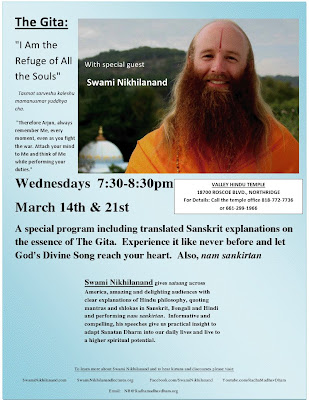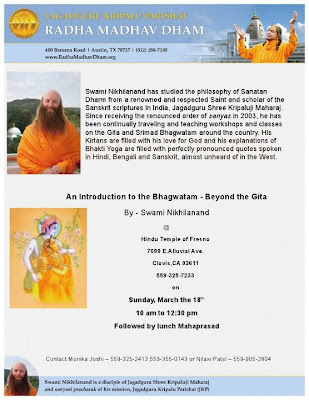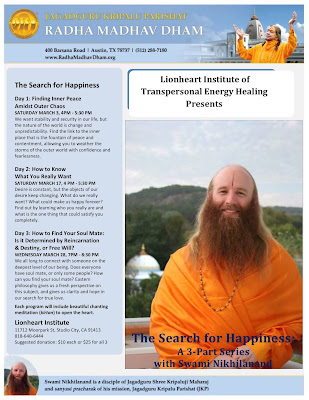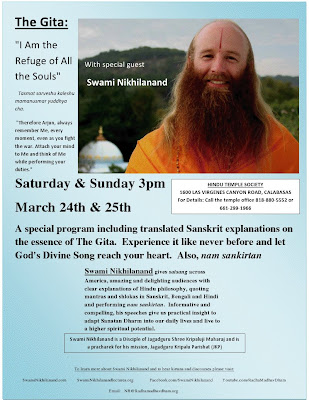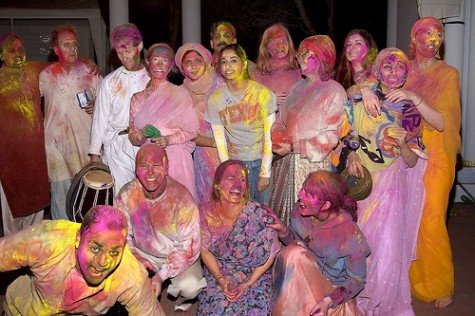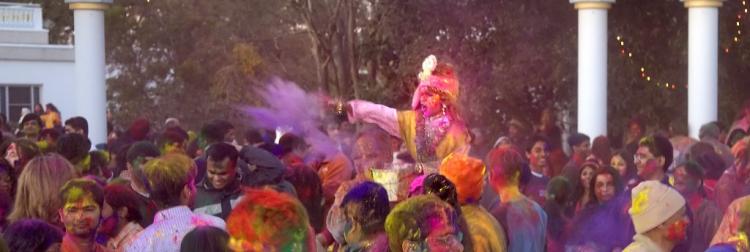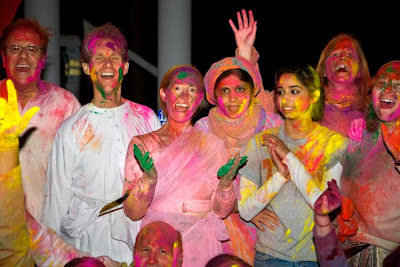
Ram Navmi at Radha Madhav Dham begins with chanting of the Divine name of Bhagwan Ram as we celebrate the day of His Divine appearance. Following a speech highlighting the devotional and philosophical importance of this festival, there may be an opportunity to experience the darshan of Ram's darbar or perhaps watch live scenes from the Ramayan acted out by members of the community. After more nam sankirtan (chanting of the Divine name of Lord Ram) and Shree Ram Chandra arti, everyone is invited to come forward for darshan of baby Ram--a very sweet opportunity to draw closer to our Divine Beloved. Lunch prasad follows.
Ram Navmi message of Jagadguru Shree Kripaluji Maharaj's foremost disciple
The Divine souls. We are going to learn about Bhagwan Ram, when He came on this earth planet millions of years ago. He appeared in tretayug. Krishn appeared in dwaparyug. This is now kaliyug. Descensions of supreme God happen from time to time to remind us that the aim of our life is God realization. And also to reveal the fact that Divine love is so great--beyond imagination. But, that could be attained if a person understands the fact that he belongs to supreme God Krishn or Ram. He does not belong to this world.
You see, in your personality, your physical body, your mental body, and also your soul. All these three are your personality. Your soul and your mind are always together. They never die. They never take birth. They are all eternal. Body takes birth, body dies. So all the relations relate to physical body. All the happiness relates to physical body. World relates to physical body. Your soul does not relate to this world. Because soul is demanding Divine love and your mind is not understanding what is the requirement of the soul, that is a conflict. So, to clarify the situation, sometimes the supreme personality of the God Himself appears. He sends His Saints from time to time, but sometimes He Himself appears. So like this was the appearance of Bhagwan Ram, millions of years ago.
We have Ramayan in Hindi language. It is very popular. But there are many Ramayan. Ramayan means the history of Bhagwan Ram, Ramayan. Hari ananta hari katha ananata. Kah yah sunahi bahu miti saba santa. (Ramayan) Goswamiji says, "Anant, uncountable descensions of Bhagwan Ram had happened and there are many, many Ramayan that Saints ave written." So there are many kinds of Ramayan, already in the world, but they all have the history of Bhagwan Ram. Out of all of them, Valmiki Ramayan and Tulsidas Ramayan, these two are the most important. Maharshi Valmiki wrote the Ramayan during the time of Bhagwan Ram--that means millions of years ago. He wrote at the same time when Bhagwan Ram was on this earth planet. And Tulsidas Ramayan was written 500 years ago, by Goswami Tulsidasji. But he was a descended Saint--a descension of Valmiki. Anyway, these two are very important books on Bhagwan Ram. So how does this history start?
Once Parvati (Sati) and Bhagwan Shiv, They just had come to see the leela of Bhagwan Ram. And at that time, Bhagwan Ram was in the jungle and Goddess Sita was kidnapped by demon Ravan. Bhagwan Ram was lamenting, "O My Sita! Where have You gone? How will I live without You?" Like this. And Lakchman was behind Bhagwan Ram, he didn't know what to do, how to help Bhagwan Ram. So Shiv and Parvati both come. Bhagwan Shiv was so encharmed, "O My beloved Lord! How innocently You are acting like a worldly lover! You are supreme Lord, but how perfect Your acting is!" So He just prayed His supreme Lord, "O My beloved..."
But Parvati got confused. She says, "Shiv sarvgya jana sab koi. My husband God Shiv is all-knowing, and He prostrated to that person who is lamenting like a worldly lover and saying He is supreme God...it doesn't sink into My head." So, when some confusion comes into the mind you become restless. So She asked Shiv that She wants to go to check Bhagwan Ram, if He is really God, God Ram.
Shiv said, "No, don't go. You'll be in trouble."
She said, "But I want to go."
"OK go, if You want to go."
So, when She came to Bhagwan Ram, She thought it is the best to assume the form of Goddess Sita, and go in front of Him. If He is really God, He'll recognize Me. If He is not God, He'll be confused." So She assumed a form like Goddess Sita and went to Bhagwan Ram. Bhagwan Ram was actually in the same pathetic mood--ha Sita ken neeta ko bhavan ken drishta. (Valmiki Ramayan) In Valmiki Ramayan, there are so many verses like that. He was in that kind of ecstasy of love and as Sita appeared, the assumed Sita, Bhagwan Ram became serious. "O My mother! How did You come?" Because Bhagwan Ram worshipped Shiv and Shiv worshipped Bhagwan Ram. They both are Beloved of each other. He said, "O My mother! Where is My beloved God Shiv?" And Parvati was so ashamed. She just ran and came back to Shiv.
So, Shiv knew everything that had happened. Actually it was not Parvati--at that time Her name was Sati. So when Sati came to Shiv, Shiv asked, "What did You do?" She said, "I didn't do anything. Keenha pranamu tumharihi naeen." (Ramayan Balkand 55/2). "I simply went to Him, and I just prayed My homage and I came back." She lied to Shiv. And Shiv knew everything, "Oh, this Sati has assumed the form of Goddess Sita, and Goddess Sita is My mother! Now I can't accept Her." So He discarded Sati, "I can't take You back as My wife." This is the story.
Later Sati appeared again as Parvati, and Parvati got married to Shiv again. Shiv and Parvati are living happily on Kailash parvat. So Parvati again asked Bhagwan Shankar (Shiv), "Ajahun kachu sanshaya man moren (Ramayan Balkand 108 / 3), O My beloved Lord! Still I have some little doubt. It's all clear, just a little is left."
"What is left?"
"Is it the same Divine supreme Lord God who has appeared? Or some other form of God?"
Shiv says, " O Parvati! You have no doubt. Tumhin na sanshaya moh na maya. You have no confusion. You have asked this question for the sake of other souls. You on Your own have no confusion. But because You have asked for the sake of other souls, so I'll explain to You." And at that time God Shankar, He relates the whole story of Bhagwan Ram. This is Ramayan. It means it was first said by God Shiv and Parvati listened to that.
You see in that first part of the Shiv-Parvati story, as I explained just now, Shiv says, "O Parvati, You have no confusion, You are doing it for the sake of the souls." Souls have so much confusion in their mind that they criticize God. They do sly things, crafty things, lying...not knowing how little power they have, and argue in the field of Divine...the common human nature that Sati showed. So when She went to God Ram, She tried to examine Him. When She came back to Shiv, She lied to Her own husband. It's just human nature that She mimicked in that. Anyway, Shiv and Parvati or Shiv and Sati, They are one. Both Divine power. They were never confused. That's how this Ramayan came into being. So Goswamiji Tulsidasji starts the Ramayan like this.
So in Shiv and Parvati's words, the whole Ramayan is told. It's like whole of the Bhagwatam, Shukdeo and Parikshit. Shukdeo is saying, Parikshit is listening, and the whole Bhagwatam was told like that. Likewise, the Ramayan is the conversation of Shiv and Parvati.
So in this Ramayan, there are mainly seven sections starting from Bhagwan Ram's descension. One example I'll give you. When Bhagwan Ram appeared, He never took birth. He was not born. He appeared. Bhaye pragat kripala deendayala Kaushalya hitakaree (Ramayan Balkand 191 / 1). The word is pragat, prakatya, descension, appearance. So Bhagwan Ram appeared.
When Bhagwan Ram appeared, He appeared in His full bloom Divine beauty. Whatever is the regular form of God He appeared like that. Full height. His mother, Kaushalya, was just lying on a bed and she was thinking of Bhagwan Ram in her mind. In her thoughts, she saw that Bhagwan Ram appeared. She opens her eyes and Bhagwan is there. So Bhagwan Ram appeared in full form; He appeared. He didn't take birth in a worldly style. Then Kaushalya praised Bhagwan Ram and said, "Please, now become small like a one-day child." Keejai shishuleela ati priyasheela yah sukh param anoopa (Ramayan Balkand 191/4). Keejai shishuleela. "O Bhagwan Ram! Now become my son. And start playing like my son. Because this love of mother and son is something so intimate, so great, it can't be described into words." So Bhagwan Ram became like a one-day-old child. And then everybody knew, "Oh yes, yes, Bhagwan Ram is born." There was a great celebration in Ayodhya.
Bhagwan Ram's father Dashrath had more than one wife. He had three wives. From one wife, Shatrughn and Bharat were born, from one, Lakchman was born, and from one, Ram was born. There was four brothers: Ram, Lakchman, Bharat, Shatrughn. So all the four brothers were born--it means they appeared. Just a difference of a short time--not very much. And they all grew.
Once Vishwamitr came and said, "O King! My fire ceremony, my yagya, is being disturbed by some demonesses and demons. Please send your two sons to protect me." So he sent his two sons, Ram and Lakchman, to protect him. Then they were invited into another kingdom, Mithila. King Janak and his daughter Sita were in Mithila. King Janak made a promise that, "I'll wed my daughter to that person who will lift this big heavy bow of Bhagwan Shiv." So Ram lifted the bow and actually broke it. Thus the marriage was settled. King Janak also had three more daughters, so Bharat and Shatrughn were also called from Ayodhya and all four brothers got married at the same time. They stayed for a few months and then they all came back to Ayodhya.
In Ayodhya, the youngest and the most beloved wife of Dashrath was Kaikeyi. Once, her ear was poisoned by one of the maids with an idea. She said, "You see, you have two sons. Everyone loves Bhagwan Ram and Lakchman, but nobody cares about your son. Why shouldn't your son become king of Ayodhya, not Bhagwan Ram?" So Kaikeyi asked her husband, "Really I want my son, Bharat, to be the king--not Bhagwan Ram." She was so much against Bhagwan Ram being in the kingdom, she said, "No, no, Bhagwan Ram must go for 14 years in exile. My son should become king." It all is explained in the Ayodhya Kand. It is a big chapter, a big canto. There is a great description.
In this way Bhagwan Ram, Lakchman and Sita, all three went into exile and there They met all the Saints living there. They Graced all those Saints. Then Ravan came. He kidnapped Sita. Bhagwan Ram went to Lanka and killed Ravan and got Sita back and came back to Ayodhya. That's the whole Ramayan in short.
All of this happened within fourteen to fifteen years. Then Bhagwan Ram came back to Ayodhya. After that He stayed for almost eleven thousand years. He stayed in Ayodhya and ruled Ayodhya. Nothing much is said about those ten to eleven thousand years. Up until He came back to Ayodhya after killing Ravan, the whole Ramayan deals with all those events.
Once Bhagwan Ram called for all of His people and He gave a speech. Eak bar raghunatha bulae (Ramayan Uttar Kand 42/1). He gave a big speech. And then, just like Krishn gave Gita to Arjun, Bhagwan Ram gave some more knowledge to the ones who are living in the world. Bhagwan Ram gave only this one speech in His whole lifetime. He tells about gyan, about bhakti, and about karm, but He says, "Souls belong to Me, they have to come to God. Unless they find God, they will not be happy. And the path of gyan is so difficult, so pride-giving. It's very very hard to follow by an ordinary person. It's almost impossible. So bhakti is the only path through which a soul can reach God and experience the Bliss of Divine love." And then He says, "Sunahu karahu jo tumhahi sohaee (Ramayan Uttar Kand 42/2). That's My advice, now you do whatever you want."
He said this because He knows souls; he knows that they listen half-heartedly. They add half of their own mind to what they hear and do whatever they want. You see this Ram Navmi celebration, how many celebrate? Millions. Almost every Indian knows and celebrates to some extent. But how many follow the teachings of Bhagwan Ram, whatever He spoke in Ramayan? Eak bar raghunath bulae (Ramayan Uttar Kand 42/1) How many follow His speech? Very, very few. You can count on your fingers. Only those who really understand the truth of human life, those who really realize their life is for God realization and not for wasting in this world.
We see that if we recall back from our childhood up to this point, you will know that you did almost everything. You loved, you quarreled, you hated, you were dejected, you were disappointed--you did everything in the emotional field. Were you ever happy? No. Your happiness was temporary, transitory. Whenever you found a loved one, you felt happy. When that person departed, you were unhappy. When you took some revenge on someone you envied, you felt happy, "I took that revenge!" When you failed in your revenge, you were unhappy. And in both situations, the animosity was burning your heart all the time. In the material love, too, when you were happy, your heart was burning with a desire to receive more. When that person departed your heart was burning with separation. So this is called mayic agony. Material agony. This agony is all the time within you, the fire of discontentment, a kind of fire. You are discontented with every situation you are in. So those who know good, know bad. They are always together--good and bad. So in all situations you found yourself discontented to some extent, or to a great extent. That's one thing.
Now a second thing: your work was never completed. You see, in your mind, all the time you have more than one thing to do. All the time, like when you are going to bed, "Shall I sleep-in half an hour? No, 15 minutes... No read something... Take a magazine... Watch TV... No, go to sleep." See? Even going to sleep you have to think so much?
You got up early morning, "I have to do this, this, this, this. What to do first?" So all the time you have more than one thing and you must decide what to do first, what is of first preference, and what is of next preference. And you never found that everything is done. No, never done. Since your birth, up till your death, whatever you do, you will never be done completely. It will be always incomplete. Why? This is the nature of the world. It is the nature of the world for things to always be incomplete. So it is like this. Incompleteness and discontentedness is the very nature of this mayic phenomena. You live for millions and millions of lifetimes and it is always the same thing.
So why not come to God, why not come to Bhagwan Ram, Bhagwan Krishn, any form of God--why not come to Them? Bhagwan Ram said, "Sunahu karahu jo tumhahi sohaee (Ramayan Uttar Kand 42/2). I am telling you the truth. Now think over it deeply and try to understand what I have said." If souls understand this fact of life, the fact of Divine love, and the possibility of Divine attainment...that's very important, the possibility. You see on this side, on the worldly side, there is no possibility. You can never be completely contented, you can never finish your work completely forever. It is impossible! Because this is the nature of this maya. But on the other side, you can find God. Just submit yourself wholeheartedly; He is ready to Grace you. On the other side there is a possibility; on this side, there is no possibility. So come towards whatever is possible for you to do. This is the understanding.
To give this understanding to the souls, Bhagwan Ram keeps coming from time to time. He comes so Souls can understand the littleness of worldly happiness and the absoluteness of Divine love.






















